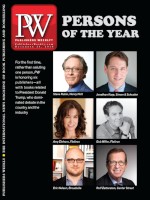When Laura Weymouth set out to write The Light Between Worlds (HarperTeen), she was responding to an unfilled niche in the market. “In 2016, I saw a tweet that a publisher was really interested in acquiring a book about Susan Pevensie after the end of the Narnia books, because Susan has always seemed to get such a raw deal,” she explains. In C.S. Lewis’s series, Susan, the second eldest of the four siblings who first visit the magical land in The Lion, the Witch, and the Wardrobe, is famously left out of The Final Battle because she has reportedly grown up and is no longer a “friend of Narnia”—she’s now only interested in “nylons and lipstick and invitations.”
For Weymouth, who had always been interested in exploring the transformative and traumatic aftereffects of adventures in children’s literature, it seemed like a sign. “I had to write this book,” she says. “If someone else did it first, they wouldn’t do it the way I wanted to see it done.”
In Weymouth’s final manuscript, which she drafted in only a few months, the Hapwell siblings—Philippa, Jamie, and Evelyn—are transported to the realm known as the Woodlands during an air raid in 1944 London. There, they spend several years participating in a whole new set of wartime conflicts before returning to the exact moment from which they left, forced to reconcile their emotional and physical changes in the Woodlands with the unchanged real world. “The Hapwell children are very much their own people and their adventure does take its own direction,” Weymouth says. “The closest I come to calling out C.S. Lewis’s dismissal of Susan is a scene where Philippa, who’s very well presented, says she uses powder and pumps as armor against the world around her.”
Much to Weymouth’s surprise, her path to publication was remarkably swift. After completing The Light Between Worlds, she pulled an existing book query out of circulation in order to focus on this one, sending it out to an initial batch of a dozen agents. “Within 10 days, I started getting offers,” she says. “I ended up choosing Lauren Spieller with TriadaUS. We went on submission with The Light Between Worlds about a month and a half later, and it was out for less than 24 hours before we started getting offers. Ultimately, it went to auction and sold in a two-book, six-figure deal. It was very fast, and very overwhelming.”
As a historical fantasy, the book plays to Weymouth’s strengths. Her focus in college was on medieval studies, although she dropped out to get married and start a family. Currently, she lives in western New York, where she juggles her writing career and raising her two children and a flock of chickens. “It’s bedlam around here,” she says.
But Weymouth maintains a passion for research. “I love doing the background reading. I’ll watch films, read novels, dig into nonfiction, try to get an accurate feel for the time period and location.” One major location for The Light Between Worlds, which is set primarily in 1949–1950 England, was London’s National Gallery—a place she researched extensively but has yet to visit, much to her regret. Instead, an archivist there helped her to convey the right sense of location and atmosphere. “Anytime you see Philippa walking through the National Gallery in the book, it’s exactly as it would have been at that time,” she says. For Weymouth, who cites Madeleine L’Engle and poet Sara Teasdale as influences, giving the Hapwell sisters an interest in poetry and artwork allowed her to incorporate her own passions into the story.
Weymouth has no plans to return to the Hapwells or the Woodlands. Instead, her next book is another standalone, a historical fantasy she describes as “Downton Abbey meets Beauty and the Beast,” entitled A Treason of Thorns. “It’s an alternate history version of the U.K., in which the well-being of the landscape is governed by five great sentient magical houses,” she explains.
In the meantime, Weymouth is happily adjusting to life after publication. “I’m surprised by how much administrative work there is,” she says. “There’re constant emails back and forth with your editors and agents and publicists. There’s keeping up with social media. There’s this real host of minutiae, and you have to be intentional about carving time to continue writing.”
But Weymouth says it’s all worth it just to hear from readers. “I’ve gotten such amazing messages from fans about how much Evelyn and Philippa’s story has touched them, and how they’ve related to this book.” That’s no surprise, since she says the two Hapwell sisters represent her to a degree. “Evelyn is a strong reflection of who I was as a teenager, when I dealt with depression and felt acutely out of place. Philippa is more who I became in my early 20s, as I became less overwhelmed by the world around me. So the two girls are a reflection of who I was and who I became, and now I’m not entirely sure what comes next. But I’m figuring it out.”



 Volume 265
Issue 52
12/24/2018
Volume 265
Issue 52
12/24/2018





